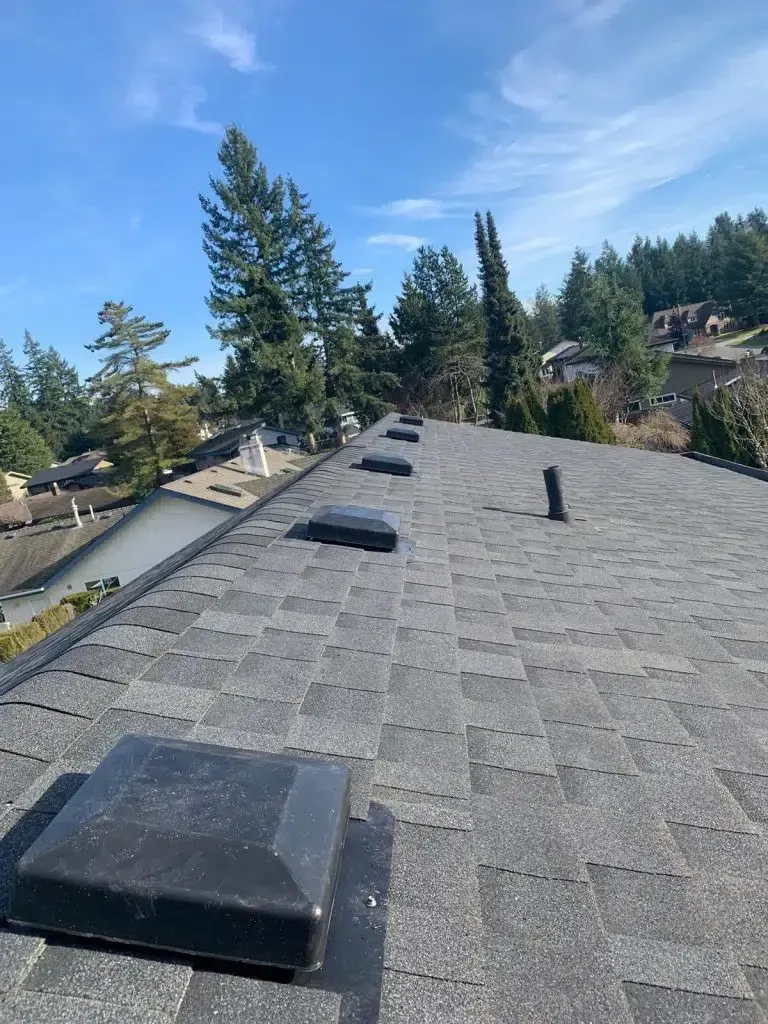Preparing Your Burnaby Roof for Winter Storms and Hail
To prepare your Burnaby roof for winter storms and hail, book a fall inspection, seal every flashing joint, clear all drainage paths, and upgrade to impact-rated shingles—simple moves that keep water, wind, and ice where they belong: outside.
- Book professional fall inspection.
- Clear gutters, downspouts, scuppers.
- Replace cracked or loose shingles.
- Upgrade to Class 4 impact shingles.
- Trim overhanging limbs safely.
The West-Coast Winter Is Warming Up—Yet Hitting Harder
Three winters ago you could shrug off a “chance of flurries”; now the phrase hides bomb-cyclone gusts that down power lines and rattle shingles loose. In 2024 alone, BC Hydro logged 1.4 million weather-related outages province-wide, its highest on record.Meanwhile, rare-as-hen’s-teeth hailstorms are no longer so rare: the November 19, 2024 cell fired marble-sized ice across Burnaby within minutes of landfall.
For a roof perched halfway between the Pacific and the Coast Mountains, that means preparing for contradicting forces—salty fog, horizontal rain, wet snowpack, and hailstones accelerated by outflow winds roaring through the Fraser canyon. I’ve spent eighteen Burnaby winters on ladders; the pattern is clear: each year the freeze-thaw line rises, moisture lingers longer, and roof assemblies that once eked out thirty years fail at twenty-five unless properly fortified.
1. Know the Local Load, Don’t Guess the Weight
Burnaby sits in BC Building Code Climate Zone 4, rain-screen country where the minimum design snow load hovers around 1.9 kPa, yet drifts along multi-level roofs can triple that figure.Account for wet density—coastal snow absorbs rain, pushing weight beyond the code’s base map. My rule of thumb: if powder reaches your bootlaces, shovel; if it slumps like oatmeal, shovel twice as soon.
2. Inspect Like a Detective, Not a Tourist
A cursory glance from the sidewalk will not reveal the blister hidden under a tab or the loosened ring-shank nail perched to lift the next gusty night. Start with the attic: look for daylight pinholes, lingering frost, and damp insulation. Outside, pay gladiator attention to valley metal—hail loves to bruise thin gauges—and to chimney crickets, which often trap snow then leak during a chinook.
3. Drainage: The Unsexy Champion
Gutters in the Lower Mainland collect moss faster than leaves. When moss mats constrict spouts, meltwater backs beneath shingle courses, refreezes overnight, and slowly pries plywood apart. Clear them in October, then again after the first storm; don’t forget parapet scuppers on flat or low-slope sections. We install 3 × 4-inch downpipes on many Burnaby bungalows now, a quiet upsizing that cuts overflow calls by half.
4. Material Choices: Class Isn’t Just for School
- Asphalt shingles: Stay with a Class 4 impact rating or expect hail pocks. Laminate styles with SBS modifiers flex in cold snaps, resisting split edges.
- Standing-seam metal: Costlier upfront, but the 24-gauge panels shrug off pea-sized hail without dimpling and shed snow cleanly when temperatures bump above freezing.
- Synthetic underlayment: Ice-and-water membrane along eaves is mandatory in my books; self-sealing bitumen halves leak risk during wind-driven rain events.
5. Fastener Upgrades: Tiny Steel, Huge Leverage
Switching from ⅜-inch galvanized staples to ring-shank nails seems trivial until you learn that uplift forces double at 70 km/h gusts—the norm in a bomb cyclone. Stainless screws on metal roofs, gasketed neoprene washers on exposed-fastener panels, and stainless clout nails on flashing edges lock the lid down.
6. Flashing: Joints Weather Never Forgives
Caulk is confession that metal was cut short. Instead, bend continuous step flashing, extend kick-outs two inches past the siding, and hem fascia flashings tight to stop those “huge gaps” homeowners photograph in panic at dusk. Where chimney lead meets brick, lace counter-flashing two courses high; mortar joints degrade faster under de-icing salts tracked up ladders.
7. Ventilation & Insulation: Let the Roof Breathe, Keep the House Warm
A Burnaby attic wants roughly 1 sq ft net free vent per 300 sq ft ceiling area when balanced intake/exhaust exist. Good airflow purges moist interior air, preventing frost sheets that thaw and drip when temperatures yo-yo. Pair that with R-50 cellulose or mineral wool; both retain loft when damp and blunt hail impact noise.
8. Hail-Specific Shields
During forecasted hail cells, deploy sacrificial covers—heavy tarps or purpose-built hail blankets—over skylights and solar collectors. Consider installing polycarbonate dome shields; they outperform glass by 200 J in impact tests yet weigh a fraction. After the event, chalk-mark every dent for insurance before sun fades impressions.
9. Emergency Toolkit for Homeowners
| Item | Use | Why it Matters |
|---|---|---|
| Telescoping roof rake | Snow removal from ground | Lowers avalanche risk |
| 6 mil polyethylene | Temporary leak patch | Buys repair time |
| Headlamp | Night inspections | Storms love darkness |
| Non-conductive ladder | Post-outage checks | Avoids live wire shock |
10. Post-Storm Protocol
- Walk the perimeter; photograph debris lines.
- Scan ceilings indoors for new rings.
- Check attic humidity (aim < 60 %).
- Call your roofer if granules clog downspouts.
- File insurance within 48 hours of hail strike.
Time is warranty’s twin: wait a week and that manufacturer guarantee can evaporate.
Frequently Asked Questions
How often should I have my Burnaby roof inspected?
Twice a year—once in mid-autumn, once after the final spring thaw—catches seasonal damage before it grows.
Can I clean moss myself?
Yes, but avoid pressure washers; use a gentle bristle broom and a potassium-salt solution, then rinse lightly 24 hours later.
Are ice dams common in Burnaby?
Less common than in Whistler, but hybrid snow-rain events can build dams overnight when temps hover around zero.
Final Thoughts From the Ladder-Top
Preparing a roof is less grand than installing one, yet the hidden heroics—swapped nails, cleared valleys, fresh bead of sealant under a ridge cap—decide whether your living-room drywall stains brown in February. Burnaby weather oscillates between Pacific drizzle and Arctic outflow in a single day; roofs built to median conditions fail at extremes. Build, inspect, and maintain for the extremes, and winter storms become noisy spectacles rather than catastrophes.
Written by Harman Singh, lead installer and project manager at Paragon Roofing BC, proudly keeping Burnaby homes dry since 2007.
Looking for hands-on help? Read our detailed guide on winter roof prep in Burnaby for service options and booking.



